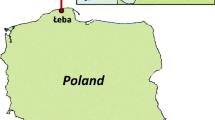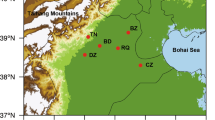Abstract
The seasonal variations of refractivity gradients from 104 to 3000 m above ground level in the troposphere layer are presented based on observations from the radiosonde station located in Ngaoundere (13.5°E, 7.3°N), a middle belt savannah region of Cameroon. Six years (2006–2011) of data from in situ measurements made by Agency for the Safety of Air Navigation in Africa and Madagascar (ASECNA) of the temperature, moisture, and pressure are used to determine the surface duct conditions over Ngaoundere region. Each time that a negative gradient from the Abel-retrieved refractivity profiles is seen, it implies the presence of a duct in this study. The occurrence of ducts strongly depends on the local climate and synoptic weather conditions which have an appreciable influence on the refractivity vertical profile, especially the seasonal north–south movement of the Inter Tropical Convergence Zone (ITCZ) which provides wet and dry seasons to the region. Monthly and seasonal variations of ducts were also determined from the measured data. The highest and the lowest occurrence rate of surface ducts were observed during the wet and the dry seasons, respectively. September appears as the month when most of the ducts occur at the rate of at least one duct per day. The median duct thickness and duct strength are high and strong during the wet season, whereas they are low and weak during the dry season. When the data are separated into stable and unstable atmospheric conditions, we noticed that surface duct characteristics show some seasonal differences. Surface ducts are found to be more frequent in a stable atmosphere than in an unstable atmosphere. Statistical results are discussed alongside with local meteorological conditions and weather systems affecting the town of Ngaoundere. Besides, comments are made on their prospective significance in the region.














Similar content being viewed by others
References
Agusti AP, Beljaars A, Ahlgrimm M, Balsamo G, Bock O, Forbes R, Ghelli A, Guichard F, Köhler M, Meynadier R, Morcrettea JJ (2010) The ECMWF re-analysis for the AMMA observational campaign. Q J R Meteorol Soc 136:1457–1472
Almond T, Clarke J (1983) Consideration of the usefulness of microwave propagation prediction methods on air-to-ground paths. Proc IEEE Part F 130:649–656
Ao CO (2007) Effect of ducting on radio occultation measurements: an assessment based on high-resolution radiosonde soundings. Radio Sci 42:RS2008. doi:10.1029/2006RS003485
Arya SP (1988) Introduction to micrometeorology. Academic Press
Babin SM (1996) Surface duct height distributions for Wallops Island, Virginia, 1985–1994. J Appl Meteorol 35:86–93
Barla MC (1986) Sur les indices de réfraction atmosphérique en Turquie. La Météorologie; VII 13:2–6
Battan LJ (1973) Radar observation of the atmosphere. University of Chicago Press
Bean BR, Dutton EJ (1968) Radio meteorology. Dover
Bech J, Bebbington DH, Codina B, Sairouni A, Lorente J (1998) Evaluation of atmospheric anomalous propagation conditions: an application for weather radars. Remote sensing for agriculture, ecosystems, and hydrology. In: Engman ET (ed) International Society for Optical Engineering (SPIE Proceedings vol. 3499), pp 111–113
Bech J, Codina B, Lorente J, Bebbington D (2002) Monthly and daily variations of radar anomalous propagation conditions: how “normal” is normal propagation? In: Proceedings of Second European Conference of Radar Meteorology, Delft, Netherlands, ERAD Publication Ser vol. 1, Copernicus GmbH, pp 35–39
Bech J, Gjertsen U, Haase G (2007) Modelling weather radar beam propagation and topographical blockage at northern high latitudes. Q J R Meteorol Soc 133:1191–1204
Bluestein HB (1993) Observations and theory of weather systems. Vol II. Synoptic-dynamic meteorology in midlatitudes. Oxford University Press
Born M, Wolf E (1999) Principles of optics, 7th edn. Cambridge University Press, New York
Borsum DL (1995) Doppler dilemma delineates danger from dirt. National Weather Service Western Region Technical Attachment 95-07, National Weather Service Field Office, Boise, ID, p 7. Available from National Weather Service Field Office, DOC/WASC, 3833 S. Development Ave., # 3807, Boise, ID 83705-5354
Brooks IM, Goroch AK, Rogers DP (1999) Observations of strong radar ducts over the Persian Gulf. J Appl Meteorol 38:1293–1310
Cook J (1991) A sensitivity study of weather data inaccuracies on evaporation duct height algorithms. Radio Sci 26:731–746
Craig KH, Hayton TG (1995) Climatic mapping of refractivity parameters from radiosonde data. In: Proceeding Conference 567 on Propagation Assessment in Coastal Environments, Bremerhaven, Germany, AGARD-NATO, 43, pp 1–14
Dalmaz M (1977) Variation de la réfraction atmosphérique en fonction de la température à Göztepe. La Météorologie; VI 10: 113–124
Deniz A, Karaca M, Borhan Y (1997) A climatological study on the relationship between cyclone paths and air pollutants in Turkey. Environ Res Forum 7–8:360–366
Ding J, Fei J, Huang X et al (2013) Observational occurrence of tropical cyclone duct from dropsonde data. J Appl Meteorol Climatol 2013(52):1221–1236
Dockery GD (1988) Modeling electromagnetic wave propagation in the troposphere using the parabolic equation. IEEE Trans Antennas Propag 36:1464–1470
Erinc S (1984) Klimatoloji ve Metodlari (Methods of climatology). Gunay Matbaasi, p 540
Falodun SE, Ajewole MO (2006) Radio refractive index in the lowest 100-m layer of the troposphere in Akure, South Western Nigeria. J Atmos Solar Terr Phys 68(2):236–243
Falodun SE, Okeke PO (2012) Radiowave propagation measurements in Nigeria (preliminary reports). Theor Appl Climatol 2013 113:127–135
Freehafer JE (1988) Tropospheric refraction. Propagation of short radio waves. In: Kerr DE (ed) Peninsula Publishing, pp 9–22
Gossard EE (1977) Refractive index variance and its height distribution in different air masses. Radio Sci 12:89–105
Kadioglu M (1997) Trends in surface air temperature data over Turkey. Int J Climatol 17:511–520
Kaissassou S, Lenouo A, Tchaouwa C, Lopez P, Amadou TG (2015) Climatology of anomalous propagation radar over West Africa. J Atmos Solar Terr Phys 123(2015):1–12
Lenouo A (2012) Climatology of anomalous propagation radar over Douala, Cameroon. Meteorol Appl. doi:10.1002/met.1321
Lenouo A, Monkam D, Vondou DA, Tanessong RS, Mkankam Kamga F (2009) Analyse des conditions météorologiques pour la sécurité aérienne `a Douala. La Météorol 65:46–58
Lopez P (2009) A 5-year 40-km-resolution global climatology of superrefraction for ground-based weather radars. J Appl Meteorol Climatol 48:89–110
Mentes S, Kaymaz Z (2007) Investigation of surface duct conditions over Istanbul, Turkey. J Appl Meteorol Climatol 46:318–337
Mesnard F, Sauvageot H (2010) Climatology of anomalous propagation radar echoes in a coastal area. J Appl Meteorol Climatol 49:2285–2300
Mohr KI, Thorncroft CD (2006) Intense convective systems in West Africa and their relationship to the African easterly jet. Q J R Meteorol Soc 132:163–176
Moszkowicz S, Ciach GJ, Krajewski WF (1994) Statistical detection of anomalous propagation in radar reflectivity patterns. J Atmos Ocean Technol 11:1026–1034
Ojo O (1977) The climates of West Africa. Heinneman, London, pp 60–72
Parker DJ, Fink A, Janicot S, Ngamini JB, Douglas M, Afiesimama E, Panareda AA, Beljaars A, Dide F, Diedhiou A, Lebel T, Polcher J, Redelsperger JL, Thorncroft C, Wilson GA (2008) The AMMA radiosonde program and its implications for the future of atmospheric monitoring over Africa. Bull Am Meteorol Soc. doi:10.1175/2008BAMS2436.1
Patterson WL (1982) Climatology of marine atmospheric refractive effects: a compendium of Integrated Refractive Effects Prediction System (IREPS) historical summaries. NOSC Technol Doc. 573, 522 pp [NTIS AD-A155 241/3/XAB.]
Penlap EK, Matulla C, Storch HV, Mkankam KF (2004) Downscaling of GCM scenarios to assess precipitation changes in the little rainy season (March–June) in Cameroon. Clim Res 26:85–96
Pratte JF, Keeler RJ, Gagnon R, Sirmans D (1995) Clutter processing during anomalous propagation conditions. In: Preprints, 27th Conference on Radar Meteorology, Vail, CO. Am Meteorol Soc: 139–141
Saucier J (1955) Principles of meteorological analysis. Dover
Sokolovskiy S (2003) Effect of superrefraction on inversions of radio occultation signals in the lower troposphere. Radio Sci 38(3):1058. doi:10.1029/2002RS002728
Steiner M, Smith JA (2002) Use of three dimensional reflectivity structures for automated detections and removal of non-precipitating echo in radar data. J Atmos Ocean Technol 19:673–686
Stull RB (1989) An introduction to boundary layer meteorology. Kluwer Academic
Stull RB (1991) Static stability—An update. Bull Am Meteorol Soc 72:1521–1529
Tatli H, Dalfes N, Mentes S (2005a) A statistical downscaling method for monthly total precipitation over Turkey. Int J Climatol 24:161–180
Tatli H, Dalfes N, Mentes S (2005b) Surface air temperature variability over Turkey and its connection to large-scale upper air circulation via multivariate techniques. Int J Climatol 25:331–350
Tchakoutio SA, Nzeukou A, Tchawoua C (2012) Intraseasonal atmospheric variability and its interannual modulation in Central Africa. Meteorol Atmos Phys. doi:10.1007/s00703-012-0196-6
Turton JD, Bennets DA, Farmer SFG (1988) An introduction to radio ducting. Meteorol Mag 117:245–254
Willoughby AA, Aro TO, Owolabi IE (2002) Seasonal variations of radio refractivity gradients in Nigeria. J Atmos Solar Terr Phys 64:417–425
Acknowledgments
The authors are very grateful to ASECNA-Ngaoundere for making available the radiosonde data of the Ngaoundere airport used for the analysis. This work benefited from helpful discussions with Kamsu Tamo P. H. and Roméo Chamani (University of Douala).
Author information
Authors and Affiliations
Corresponding author
Additional information
Responsible Editor: R. Roebeling.
Rights and permissions
About this article
Cite this article
Kaissassou, S., Lenouo, A., Nzeukou, A. et al. Seasonal variations of surface duct conditions in Ngaoundere, North Cameroon. Meteorol Atmos Phys 127, 659–674 (2015). https://doi.org/10.1007/s00703-015-0387-z
Received:
Accepted:
Published:
Issue Date:
DOI: https://doi.org/10.1007/s00703-015-0387-z




